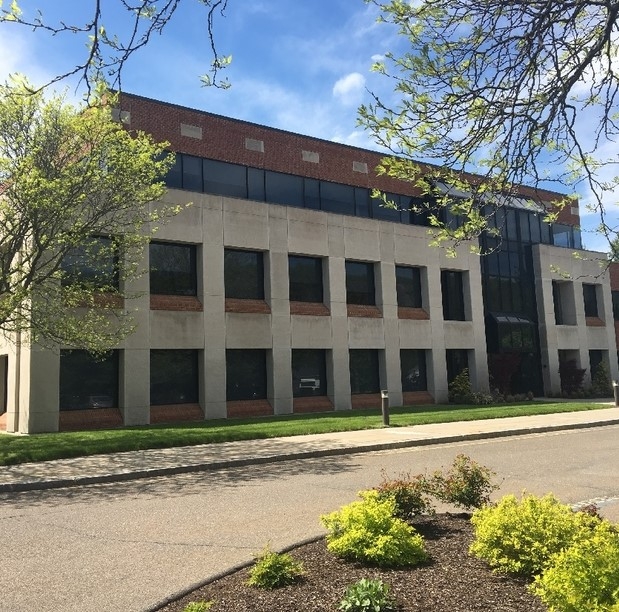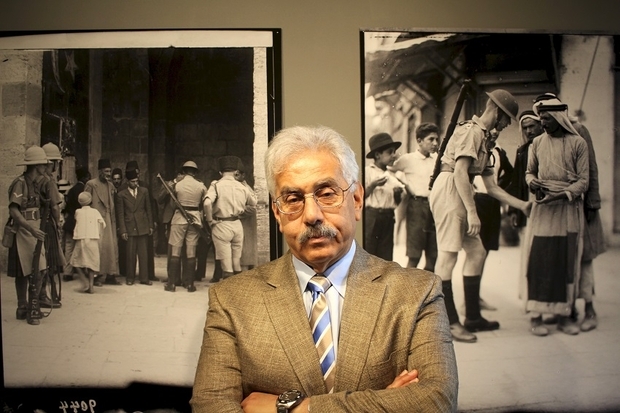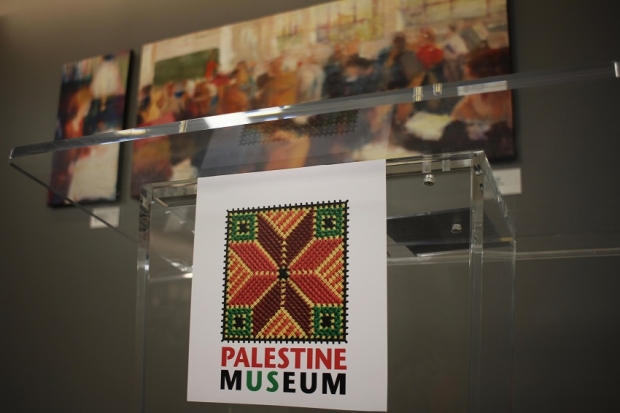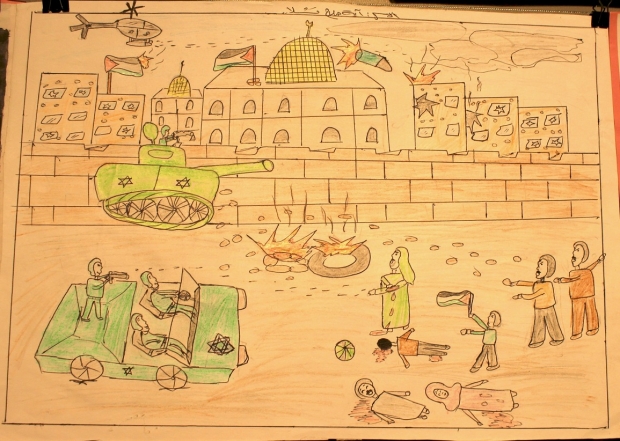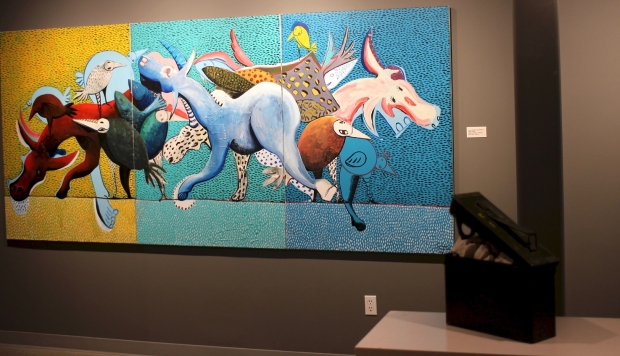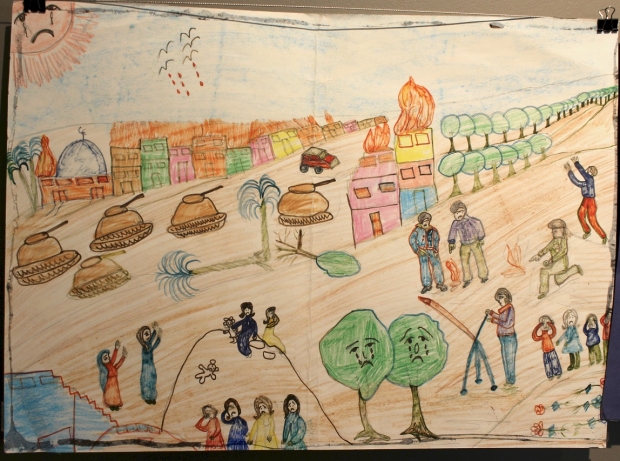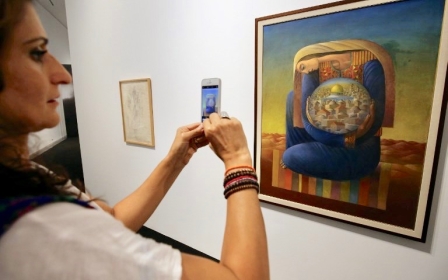America, meet Palestine: US gets its first Palestinian art museum

WOODBRIDGE, United States - The Woodbridge Corporate Park looks much like any of the other ubiquitous office parks dotting the United States’ vast oceans of suburbia. Blending into its background seamlessly, it’s the kind of place one might expect to find a dentist’s office or a call centre, a lawyer or a real estate firm.
But this Connecticut office park is home to something that separates it from all others: it is the site of the first and only Palestinian museum in the country, as well as all of north and south America, according to its Palestinian-American founder Faisal Saleh.
The Palestine Museum US opened late last month, just weeks ahead of the 70th anniversary of the mass expulsion of Palestinians from their homeland in 1948 and the creation of the state of Israel, which Palestinians call the Nakba (the catastrophe).
Funded, founded and curated by local businessman Saleh, the museum hosts more than 70 works of art as well as photographs and items of historical and cultural significance.
Tucked in an office park and constrained by budget and space, the museum is a small but significant first step towards a larger goal: to change perceptions on Palestine and introduce average Americans to Palestinian culture and art.
Changing perceptions
“The people in the US really don’t have a good idea of what the Palestinians are like, who they are,” said Saleh. “For many Americans, they know nothing about Palestinians. You say Palestine, they think it’s Israel. Even the very simple things: people now think that falafel is Israeli food and they think that hummus is Israeli food.”
The people in the US really don’t have a good idea of what the Palestinians are like, who they are
- Faisal Saleh, founder of Palestine Museum US
However, it’s not just that Americans don’t know much about Palestinians; many hold negative views of them and are unsympathetic to their plight.
In a 2016 Arab American Institute poll, 49 percent of Americans said they view Palestinians unfavourably. And a poll by Gallup earlier this year showed that 64 percent of Americans sympathise with Israelis over Palestinians.
Meanwhile, under the presidency of Donald Trump, the US government has placed itself firmly in Israel’s corner and taken an increasingly hostile stance towards Palestinians. In the past week, the US moved its embassy to the disputed city of Jerusalem and has defended Israel’s deadly use of force against Palestinian protesters in Gaza, which has left over 60 Palestinians dead.
People now think that falafel is Israeli food and they think that hummus is Israeli food
- Faisal Saleh, founder of Palestine Museum US
The museum “certainly hasn’t come a moment too soon,” said Margaret Olin, an American senior researcher at nearby Yale University whose photographs of the Dheisheh refugee camp in the West Bank are on display at the museum. “And maybe, amid all the dreadful things going on right now, gives its timing a certain urgency.”
“I think it's very important to change people’s perceptions of Palestinians,” she added. But she admits, “I find that very, very hard to do.”
Politics is part of life
While hoping to change perceptions of Palestinians, Saleh is also quick to point out that the museum is decidedly apolitical, saying that it hopes to steer clear of the often heated political debates that surround the Israeli-Palestinian conflict.
Yet separating art from politics is not easy for Palestinian artists who through their work are reflecting their surroundings, their lives, their hopes and their fears.
An installation by Palestinian-American artist Rajie Cook called A Time to Cast Stones features an ammunition box filled with rocks, a reference to the unbalanced military strength in the conflict and how Israeli troops have repeatedly responded to rock-throwing protesters with bullets.
I think it's very important to change peoples’ perceptions of Palestinians
- Margaret Olin, senior researcher at Yale University
“Politics is part of life and the politics in Palestine looms so much over Palestinian identity that it’s hard for the artist to avoid it,” said Olin, the Yale researcher.
Samia Halaby is a Jerusalem-born Palestinian artist who lives in New York. Born in 1936, she was expelled from Palestine alongside her family during the Nakba in 1948, fleeing to Lebanon and then the US in 1951. The retired professor of Yale University's school of art, whose work is on display at the museum, agreed that it is difficult to separate art and politics.
An unlikely curator
Saleh’s role as the museum’s curator is as unlikely as the museum’s location. He has no formal background in art and even admits that he was not particularly interested in art before the idea of the museum.
But what he did have was a bit of money, vacant office space in a corporate park owned by his family, and a passion to introduce Americans to the Palestinian people.
Saleh started planning the museum in June of last year with $500,000 from his own pocket. Then just 10 months later, the museum was open.
Politics is part of life and the politics in Palestine looms so much over Palestinian identity that it’s hard for the artist to avoid it
- Margaret Olin, senior researcher at Yale University
By hosting the museum in a space he owned, relying on volunteers and asking that works of art be loaned or donated, he was able to build an art museum on a relatively paltry budget. He credits the entrepreneurial skills he gained in the business world for the low-cost approach and being able to open the museum so quickly.
“I wasn't really into art in general and I am kind of learning about it,” Saleh said. “But I think you can create a museum without having to be an art expert.”
“I just used my common sense, what looked good to me,” he said of selecting artwork to exhibit.
As he put his museum plan into motion, Saleh started messaging Palestinian artists on Facebook asking if they would be willing to loan or donate work to his museum. Some were too high profile or too busy to respond, but many did.
Before the museum opened, Saleh faced hurdles in getting artwork from the West Bank and Gaza to Connecticut, a process complicated by Israeli checkpoints and customs.
For some pieces, we had to wait six weeks for it to get here - and it was shipped by FedEx
- Faisal Saleh, founder of Palestine Museum US
“For some pieces, we had to wait six weeks for it to get here - and it was shipped by FedEx. Normally from FedEx you get it in two days, but just getting it to the point where it gets on a FedEx airplane is pretty drawn out,” he said.
While the museum was opened in the office park to save money, Saleh hopes that it will attract the attention of investors and one day open in a larger city where it could attract more visitors.
But for now, the Palestine Museum US remains a small time operation, relying on volunteers and only open four hours per week on Sunday afternoons.
“The only thing that’s really needed to accomplish the growth is funding. The model is already established,” said Saleh. “Everything is functioning and operational. And it doesn’t take much to expand what we’re doing. All that’s needed is just additional financial resources.”
'A harbinger of hope and optimism'
The museum also seeks to give Palestinian artists exposure they might otherwise lack as well as providing people of Palestinian heritage a place where they can come to connect with their homeland.
“In the heart of each Palestinian there is an enduring sadness that bubbles to the surface whenever events like the massacre in Gaza is taking place,” said Halaby, the Palestinian artist. “A place like the museum brings people together to share these same feelings, the same heritage and the same sensation of what is beautiful and what is important.”
At 81, Halaby never thought she would see such a museum in the US. “It was a great, wonderful, pleasant surprise. A harbinger of hope and optimism,” she said.
Palestinian artists, including Halaby and others exhibiting at the museum, have at times faced difficulties displaying their works in the US.
And more than a decade ago, Halaby’s work was part of an art exhibition called “Made in Palestine” that struggled to find exhibition space as galleries across the country feared sparking controversy. In New York, several state lawmakers complained that the exhibition supported terrorism. After debuting in Houston, the show eventually found galleries in San Francisco, Vermont, and New York willing to host it.
For an artist in Gaza, this is an opportunity to be seen not only in Woodbridge and Connecticut, but also worldwide. It’s an outlet for cultural thinking
- Samia Halaby, Palestinian artist
“The art world is not necessarily at all sympathetic to me as a female Palestinian - or a Palestinian of any gender," said Halaby.
The Palestine Museum US provides a space where Palestinian artists can display their work freely, without the worries other galleries may have about blowback for the sometimes very political nature of their works.
For artists who remain in the West Bank, Gaza and Israel, the museum offers exposure to foreign audiences - and markets - that they might not have been able to reach.
“This encourages artists greatly to know that someone cares and that there is a sympathetic audience for that work,” said Halaby.
“For an artist in Gaza, this is an opportunity to be seen not only in Woodbridge and Connecticut, but also worldwide. It’s an outlet for cultural thinking.”
Middle East Eye propose une couverture et une analyse indépendantes et incomparables du Moyen-Orient, de l’Afrique du Nord et d’autres régions du monde. Pour en savoir plus sur la reprise de ce contenu et les frais qui s’appliquent, veuillez remplir ce formulaire [en anglais]. Pour en savoir plus sur MEE, cliquez ici [en anglais].


